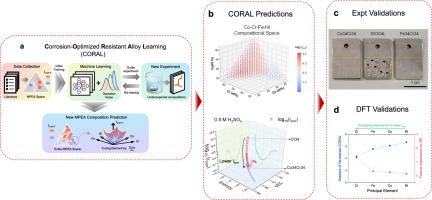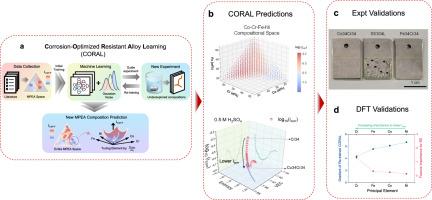面向耐腐蚀Co-Cr-Fe-Ni mpea机理发现的微结构不可知深度学习
IF 9.3
1区 材料科学
Q1 MATERIALS SCIENCE, MULTIDISCIPLINARY
引用次数: 0
摘要
在多主元素合金(mpea)中,巨大的成分设计空间和有限的微观结构腐蚀数据的可用性给耐腐蚀成分的预测设计带来了重大挑战。传统的方法严重依赖于反复试验和详细的微观结构表征,这既耗时又耗费资源。在这项工作中,我们开发了一个微观结构不可知的深度学习框架,直接从基于成分的描述符预测Co-Cr-Fe-Ni mpea的耐腐蚀性。通过整合物理信息特征、主动学习和不确定性量化,该模型可以捕获关键的物理化学趋势,而无需明确的结构输入。该框架可快速识别具有优异耐腐蚀性的非等原子成分,在酸性和富氯化物条件下均优于304L不锈钢。通过将模型预测的腐蚀趋势与密度泛函理论(DFT)的电子结构性质联系起来,获得了对腐蚀机制的基本见解。最耐腐蚀的成分-例如。, Fe34Cr34和co34cr34表现出较高的电子功函数和氧结合能,显示出较强的钝化倾向。腐蚀表面的原子探针断层扫描(APT)证实,与传统的富cr mpea (~ 14 nm)相比,这些合金形成了更薄(~ 9 nm)和更具保护性的钝化膜。机器学习模型中的特征重要性分析与dft计算的元素对表面能量的贡献一致,揭示了Cr >; Fe > Co >; Ni在促进钝化方面的一致排名。本文章由计算机程序翻译,如有差异,请以英文原文为准。


Microstructure-agnostic deep learning for mechanistic discovery of corrosion-resistant Co-Cr-Fe-Ni MPEAs
In multi-principal element alloys (MPEAs), the vast compositional design space and limited availability of microstructure-resolved corrosion data pose significant challenges to the predictive design of corrosion-resistant compositions. Traditional approaches rely heavily on trial-and-error experimentation and detailed microstructural characterization, which are time-consuming and resource-intensive. In this work, we develop a microstructure-agnostic deep learning framework that predicts the corrosion resistance of Co-Cr-Fe-Ni MPEAs directly from composition-based descriptors. By integrating physics-informed features, active learning, and uncertainty quantification, the model captures key physicochemical trends without requiring explicit structural input. The framework rapidly identifies non-equiatomic compositions with superior corrosion resistance, validated experimentally to outperform 304 L stainless steel under both acidic and chloride-rich conditions. Fundamental insights into corrosion mechanisms were obtained by linking model-predicted corrosion trends with electronic structure properties from density functional theory (DFT). The most corrosion-resistant compositions—e.g., Fe34Cr34 and Co34Cr34—exhibit high electron work functions and oxygen binding energies, indicative of strong passivation tendencies. Atom probe tomography (APT) of corroded surfaces confirms that these alloys form thinner (∼9 nm) and more protective passive films compared to conventional Cr-rich MPEAs (∼14 nm). Feature importance analysis within the machine learning model aligns with DFT-calculated elemental contributions to surface energetics, revealing a consistent ranking of Cr > Fe > Co > Ni in promoting passivation.
求助全文
通过发布文献求助,成功后即可免费获取论文全文。
去求助
来源期刊

Acta Materialia
工程技术-材料科学:综合
CiteScore
16.10
自引率
8.50%
发文量
801
审稿时长
53 days
期刊介绍:
Acta Materialia serves as a platform for publishing full-length, original papers and commissioned overviews that contribute to a profound understanding of the correlation between the processing, structure, and properties of inorganic materials. The journal seeks papers with high impact potential or those that significantly propel the field forward. The scope includes the atomic and molecular arrangements, chemical and electronic structures, and microstructure of materials, focusing on their mechanical or functional behavior across all length scales, including nanostructures.
 求助内容:
求助内容: 应助结果提醒方式:
应助结果提醒方式:


